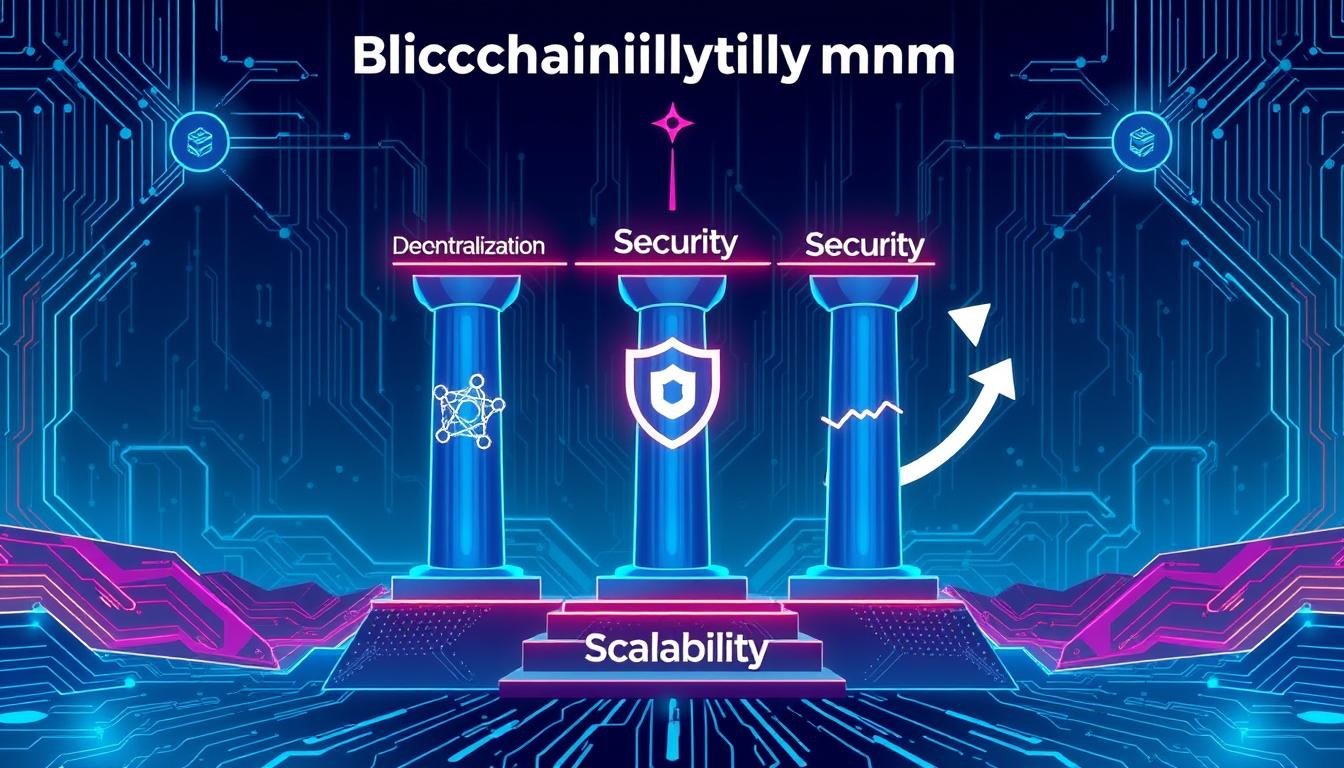Blockchain Scalability: Trilemma Explained
Blockchain technology is changing the game in many fields. But, it faces special challenges because it’s decentralized. The Blockchain Trilemma says public blockchains must choose between security, decentralization, or scalability. It’s a big goal to have a network that’s both secure and can handle lots of transactions.
A global team of experts is working hard to find solutions. They’re focusing on Layer-1 and Layer-2 technologies to tackle this problem.
Key Takeaways
- The Blockchain Trilemma refers to the trade-off between security, decentralization, and scalability in blockchain networks.
- Achieving optimal performance across all three properties simultaneously is the key challenge for blockchain developers.
- Consensus mechanisms like Proof of Work and Proof of Stake play a crucial role in balancing the trilemma.
- Layer-1 and Layer-2 solutions, such as sharding and nested blockchains, aim to enhance scalability without compromising decentralization and security.
- Overcoming the Blockchain Trilemma is essential for unlocking the full potential of blockchain technology across various industries.
Understanding the Blockchain Trilemma
The blockchain trilemma is a big challenge for blockchain networks. They must balance decentralization, security, and scalability. Finding the right balance is hard for the industry.
What Is Decentralization?
Decentralization is key to blockchain technology. It removes middlemen and spreads out decision-making. But, a very decentralized network can slow down, making it hard to scale.
What Is Blockchain Security?
Blockchain security is crucial. A 51% attack can change transactions and harm the network. Keeping the network safe is a big task, but it can limit scalability and decentralization.
What Is Scalability?
Scalability means a blockchain can handle lots of transactions without slowing down. But, focusing on speed and decentralization can make security weak. On the other hand, prioritizing security and speed might mean less decentralization.
The blockchain trilemma shows the trade-offs between decentralization, security, and scalability. Projects must find a way to balance these to meet today’s digital needs.
| Characteristic | Description | Example |
|---|---|---|
| Decentralization | Eliminating intermediaries and decentralizing consensus | Bitcoin and Ethereum networks |
| Blockchain Security | Ensuring the network’s integrity and preventing 51% attacks | Ripple’s more centralized network |
| Scalability | Supporting high transactional throughput without performance degradation | Visa’s 24,000 transactions per second (TPS) capability |
The blockchain trilemma is a complex challenge. It drives innovation and testing in the industry. As blockchain tech grows, finding ways to balance decentralization, security, and scalability is a top goal for developers and researchers.
Blockchain Scalability: Trilemma Explained
The Blockchain Trilemma is a big challenge for public blockchains. It shows the trade-off between being decentralized, secure, and scalable. Most agree that a public blockchain can only get two of these three at a time. Choosing which two is key for blockchain developers.
Decentralized Network Challenges: Making a network more decentralized and secure often means it can’t handle as many transactions. For example, Bitcoin can only process about 7 transactions per second. This shows its scalability limit.
Consensus Protocol Tradeoffs: Bitcoin and Ethereum use Proof-of-Work (PoW) to validate transactions. This requires a lot of computing power, slowing down the network. Ethereum is moving to Proof-of-Stake (PoS) to improve its speed and efficiency.
Throughput Limitations: Even big, centralized blockchains like Hyperledger’s Fabric struggle with scalability. Public blockchains like Ethereum Classic have faced security issues, like 51% attacks. This shows the need to balance all three parts of the Blockchain Trilemma.
| Network | Transactions per Second (TPS) |
|---|---|
| Bitcoin | 7 |
| Ethereum | 15-45 |
| Visa | 1,700 |
Finding the right balance between decentralization, security, and scalability is crucial. New solutions, like layer-2 technologies and better consensus protocols, aim to solve the Blockchain Trilemma. They aim to make blockchain technology more practical for everyone.
Solving the Blockchain Trilemma: Layer 1
The Blockchain Trilemma is a big challenge. It’s about making blockchain networks decentralized, secure, and scalable at the same time. But, new Layer 1 solutions are coming to solve this problem.
Consensus Protocol Improvements
One big change is moving from Proof-of-Work (PoW) to Proof-of-Stake (PoS) consensus. PoS is more energy-efficient. Networks like Ethereum 2.0 can handle more transactions without losing decentralization or security.
Validators in PoS networks stake their cryptocurrency. This makes them want to help the network, not harm it. It also lowers the chance of big attacks.
Sharding Techniques
Sharding is another key Layer 1 solution. It breaks the blockchain into smaller, parallel networks called shards. This lets many transactions happen at once, making the network faster.
Protocols like Ethereum 2.0, Zilliqa, and Tezos are using sharding. They’re working on Layer 1 Scalability Solutions to make their networks better.
By improving consensus and using sharding, blockchain networks can get much faster. These steps in Proof-of-Stake Consensus and Sharding Techniques open up new possibilities for blockchain apps and services.
Solving the Blockchain Trilemma: Layer 2
Blockchain networks face a big challenge: the blockchain trilemma. This is about balancing decentralization, security, and scalability. Layer 2 solutions offer a way to improve this balance. They work on top of the main blockchain, making transactions faster and more efficient.
Nested Blockchains
Nested blockchains are a Layer 2 solution. They have a main blockchain that sets rules and oversees the network. This main blockchain handles big tasks, while smaller chains, or “nested” blockchains, do smaller tasks.
This setup makes the main blockchain work less hard. It means the network can handle more transactions without losing decentralization or security. Projects like Liquid Network and OMG Plasma show how this works well.
State Channels
State channels are another Layer 2 solution. They let users do many transactions off the main blockchain. Only the final transaction is recorded, making the network much faster.
Projects like the Lightning Network for Bitcoin and Celer Network use this method. They aim to make their blockchains more scalable. Ethereum’s Raiden Network also works this way.
Layer 2 solutions help blockchain networks solve the trilemma. This makes them more useful for everyday use. As technology grows, these solutions will be key to unlocking blockchain’s full potential.
| Scalability Metric | Bitcoin | Ethereum | Litecoin | Ripple | Stellar Lumens |
|---|---|---|---|---|---|
| Transactions per Second (TPS) | 7 | 15 | 56 | 1,500 | 1,000 |
Overcoming the Blockchain Trilemma: Innovative Solutions
The blockchain world is growing, and new ways to solve the Blockchain Trilemma are coming up. Layer 1 and Layer 2 solutions have made big progress. But, new ideas are being looked into to make things better without losing decentralization or security.
Sidechain Scaling is a fresh approach. Sidechains use their own fast and scalable systems. They work with the main blockchain, letting it handle more transactions at once.
Cross-Chain Interoperability protocols are also being developed. They make it easy to move assets and data between blockchains. This opens up new chances for working together, more liquidity, and different uses across chains.
Looking into Proof-of-Work Alternatives is also important. New consensus methods like Proof-of-Stake (PoS) are being used. They help blockchains process more transactions and use less energy.
Thanks to these new solutions, the blockchain world is getting better. It’s moving closer to being used in everyday life.
“The blockchain industry is constantly evolving, and the emergence of innovative solutions like sidechains, cross-chain protocols, and Proof-of-Work alternatives is a testament to the resilience and ingenuity of this technology.” – Blockchain Expert
Conclusion
The Blockchain Trilemma is a big challenge for Blockchain Adoption Challenges. It’s about finding a balance between decentralization, security, and scalability. Layer 1 and Layer 2 scaling solutions, along with other new ideas, are helping to solve this problem.
As blockchain technology grows, it’s key to achieve all three important aspects at once. This will unlock the true power of decentralized networks. It will also help drive Future Outlook.
The Trilemma Impact on blockchain adoption is clear. Big platforms like Facebook and Twitter have set high standards. The Bitcoin blockchain, for example, faced issues during the 2017 bull run, with high transaction fees.
This shows the scalability challenges blockchain networks face. They need to support many users while keeping decentralization and security.
But, the blockchain community is working hard to solve these problems. They’re exploring new solutions like consensus protocol improvements and sharding. These efforts could lead to a brighter future for blockchain, with better decentralization, security, and scalability.
Source Links
- The Crypto Trilemma Explained: Problems & Solutions [2023] | BitPay
- What is the blockchain trilemma?
- Blockchain Scalability Approaches | Chainlink
- The DBS Guide to the Blockchain Trilemma
- What is the Blockchain Trilemma? | Ledger
- Blockchain Trilemma: Scaling and Security Issues | Gemini
- Ethereum Scalability Trilemma
- Blockchain Trilemma: The Ultimate Guide
- The True Trilemma for Bitcoin Layers
- Layer 1 vs Layer 2 vs Layer 3 – A Comparative Analysis of Blockchain Scaling Solutions
- Solving the Blockchain Trilemma: Decentralization, Security & Scalability – Coin Bureau
- Comparing Monolithic vs.Modular Blockchains
- What Is The Blockchain Trilemma? A Race For All Blockchains
- Blockchain Scalability – A Guide on Scalability Solutions & Trilemma | Shardeum
- What Is the Blockchain Trilemma?






